CSE 190M Web Programming
Lecture TBD: DOM, jQuery
Reading: Chapter 9
Except where otherwise noted, the contents of this document are Copyright 2012 Marty Stepp, Jessica Miller, Victoria Kirst and Roy McElmurry IV. All rights reserved. Any redistribution, reproduction, transmission, or storage of part or all of the contents in any form is prohibited without the author's expressed written permission.
for each loop
var things = ['a', 'b', 'c', 'd', 'e'];
for (idx in things) {
console.log(idx + ', ' + things[idx]);
}
0, a 1, b 2, c 3, d 4, e
functions as first-class citizens
- functions can be variables
var myfunc = function(a, x) { return a * b; }; var x = myfunc(2, 3); // 6 - functions can be parameters
function apply(a, b, f) { return f(a, b); } var x = apply(2, 3, myfunc); // 6 - functions can be return values
function getAlert(str) { return function() { alert(str); } } var myAlertFunc = getAlert("What's up!");
javascript scope
- has the same 2 scopes as PHP, global scope and function scope
- but it gets interesting when functions are first class citizens
function getAlert(str) {
var prefix = "Roy: ";
return function() {
alert(prefix + str);
}
}
var myAlertFunc = getAlert("What's up!");
myAlertFunc(); // "Roy: What's up!"
objects literals
- objects in javascript are more like associative arrays
- the keys can be any string
- you do not need quotes if the key is a valid javascript identifier
- values can be anything, including functions
- you can add keys dynamically using associative array or the
.syntax
var x = {
'a': 97,
'b': 98,
'c': 99,
'd': 199,
'mult': function(a, b) {
return a * b;
}
};
for each over object literal
var things = {'a': 97, 'b': 98, 'c': 99 };
for (key in things) {
console.log(key + ', ' + things[key]);
}
a, 97 b, 98 c, 99
JSLint
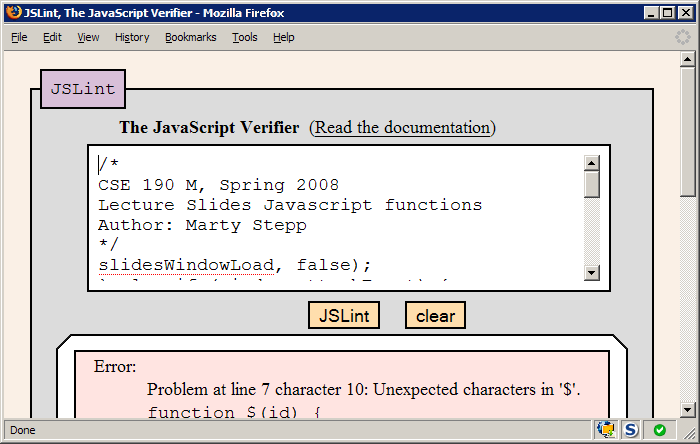
- JSLint: an analyzer that checks your JS code, much like a compiler, and points out common errors
- Web Step By Step version (recommended)
- original version, by Douglas Crockford of Yahoo!
- when your JS code doesn't work, paste it into JSLint first to find many common problems
-
Use this image and link on your webster pages:

The jQuery Library
There is no chapter about jQuery in our course book. Learning jQuery will be an exercise in your ability to navigate online APIs and documentation:
Problems with JavaScript
JavaScript is a powerful language, but it has many flaws:
- the DOM can be clunky to use
- the same code doesn't always work the same way in every browser
- code that works great in Chrome, Firefox, Safari, ... will fail in IE and vice versa
- many developers work around these problems with hacks (checking if browser is IE, etc.)
jQuery framework
<script src="https://ajax.googleapis.com/ajax/libs/jquery/1.7.2/jquery.min.js" type="text/javascript"></script>
- the jQuery JavaScript library adds many
useful features
to JavaScript:
- many useful extensions to the DOM
- adds utility functions for built-in types String, Array, Object, Function
- improves event-driven programming
- many cross-browser compatibility fixes
- makes Ajax programming easier (seen later)
jQuery Design Principles
jQuery is so powerful in part because of these design principles
- an expressive method for defining a set of elements, a superset of CSS selectors
- useful and commonly needed methods for navigating the DOM tree
- heavily overloaded APIs
- functional programmig techniques that apply operations to sets of elements at a time
- method chaining for succinct operations
window.onload
We cannot use the DOM before the page has been constructed. jQuery gives us a more compatibile way to do this.
- The DOM way
window.onload = function() { // do stuff with the DOM } - The direct jQuery translation
$(document).ready(function() { // do stuff with the DOM }); - The jQuery way
$(function() { // do stuff with the DOM });
Exercise: jQuery boilerplate
We will be working on a bouncing images example.
- Use jQuery to alert some text when the square is clicked. (Use regular DOM syntax when needed)
Aspects of the DOM and jQuery
- Identification: how do I obtain a reference to the node that I want.
- Traversal: how do I move around the DOM tree.
- Node Manipulation: how do I get or set aspects of a DOM node.
- Tree Manipulation: how do I change the structure of the page.
The DOM tree
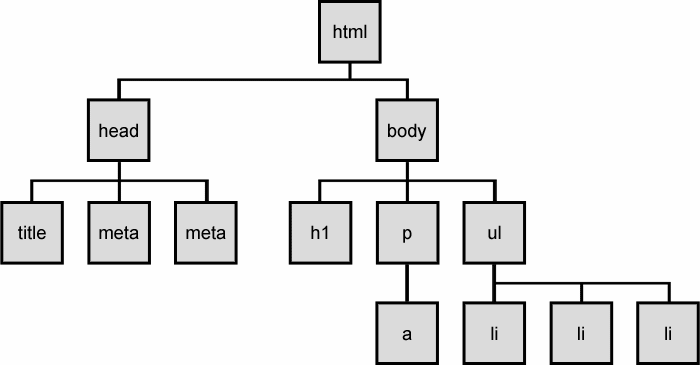
-
The elements of a page are nested into a tree-like structure of objects
- half of the challenge is singling out elements that you want
Selecting groups of DOM objects
-
methods in
documentand other DOM objects (* = HTML5):
| name | description |
|---|---|
getElementById
|
returns array of descendents with the given tag, such as "div"
|
getElementsByTagName
|
returns array of descendents with the given tag, such as "div"
|
getElementsByName
|
returns array of descendents with the given name attribute (mostly useful for accessing form controls)
|
querySelector *
|
returns the first element that would be matched by the given CSS selector string |
querySelectorAll *
|
returns an array of all elements that would be matched by the given CSS selector string |
Getting all elements of a certain type
highlight all paragraphs in the document:
var allParas = document.querySelectorAll("p");
for (var i = 0; i < allParas.length; i++) {
allParas[i].style.backgroundColor = "yellow";
}
<body> <p>This is the first paragraph</p> <p>This is the second paragraph</p> <p>You get the idea...</p> </body>
Complex selectors
highlight all paragraphs inside of the section with ID "address":
var addrParas = document.querySelectorAll("#address p");
for (var i = 0; i < addrParas.length; i++) {
addrParas[i].style.backgroundColor = "yellow";
}
<p>This won't be returned!</p>
<div id="address">
<p>1234 Street</p>
<p>Atlanta, GA</p>
</div>Ploblems with DOM API
// identifying a single elemnt var list = document.getElementById("mylist"); // identifying a group of elements var specials = document.querySelectorAll("li.special");
- Not always implemented the same way in all browsers.
- Way too verbose considering the DOM is the main thing we play with.
- Why are there 5+ methods to identify elements that all behave differently and take different kinds of parameters?
jQuery node identification
The $ aka jQuery function selects elements from the DOM using most any CSS selector.
-
// id selector var elem = $("#myid"); -
// group selector var elems = $("#myid, p"); -
// context selector var elems = $("#myid < div p"); -
// complex selector var elems = $("#myid < h1.special:not(.classy)");
jQuery Selectors
jQuery / DOM comparison
| DOM method | jQuery equivalent |
|---|---|
getElementById("id")
|
$("#id")
|
getElementsByTagName("tag")
|
$("tag")
|
getElementsByName("somename")
|
$("[name='somename']")
|
querySelector("selector")
|
$("selector")
|
querySelectorAll("selector")
|
$("selector")
|
Exercise: square identification
- Use jQuery selectors to identify elements with these properties in a hypothetical page:
- All
ptags that have no children, but only if they don't have a class ofignore - Any element with the text "REPLACE_ME" in it.
- All
divtags with a child that has a class ofspecial - All heading elements (
h1,h2,h3,h4,h5,h6) - Every other visible
li.
- All
- Use the DOM API to target the
#squareand periodically change it's position in a random direction. - Use jQuery selectors instead of the DOM API.
jQuery Terminology
- the jQuery function
- refers to the global
jQueryobject or the$function depending on the context - a jQuery object
- the object returned by the jQuery function that often represents a group of elements
- selected elements
- the DOM elements that you have selected for, most likely by some CSS selector passed to the jQuery function and possibly later filtered further
The jQuery object
- The
$function always (even for ID selectors) returns an array-like object called a jQuery object. - The jQuery object wraps the originally selected DOM objects.
- You can access the actual DOM object by accessing the elements of the jQuery object.
// false document.getElementById("id") == $("#myid"); document.querySelectorAll("p") == $("p"); // true document.getElementById("id") == $("#myid")[0]; document.getElementById("id") == $("#myid").get(0); document.querySelectorAll("p")[0] == $("p")[0];
Using $ as a wrapper
$adds extra functionality to DOM elements- passing an existing DOM object to
$will give it the jQuery upgrade
// convert regular DOM objects to a jQuery object
var elem = document.getElementById("myelem");
elem = $(elem);
var elems = document.querySelectorAll(".special");
elems = $(elems);
DOM context identification
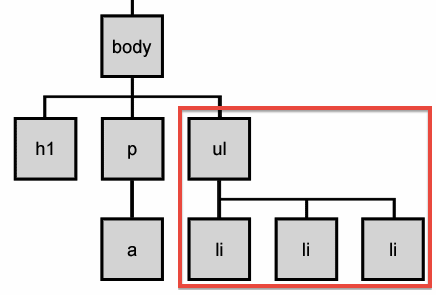
- You can use
querySelectorAll()andquerySelector()on any DOM object. - When you do this, it simply searches from that part of the DOM tree downward.
- Programmatic equivalent of a CSS context selector
var list = document.getElementsByTagName("ul")[0];
var specials = list.querySelectorAll('li.special');
find / context parameter
jQuery gives two identical ways to do contextual element identification
var elem = $("#myid");
// These are identical
var specials = $("li.special", elem);
var specials = elem.find("li.special");
Types of DOM nodes
<p> This is a paragraph of text with a <a href="/path/page.html">link in it</a>. </p>
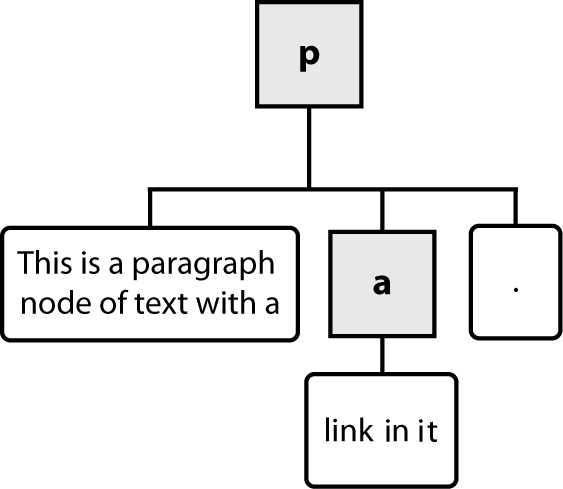
 element nodes (HTML tag)
element nodes (HTML tag)
- can have children and/or attributes
 text nodes (text in a block element)
text nodes (text in a block element)
 attribute nodes (attribute/value pair)
attribute nodes (attribute/value pair)
- text/attributes are children in an element node
- cannot have children or attributes
- not usually shown when drawing the DOM tree
Traversing the DOM tree
every node's DOM object has the following properties:
| name(s) | description |
|---|---|
firstChild, lastChild
|
start/end of this node's list of children |
childNodes
|
array of all this node's children |
nextSibling, previousSibling
|
neighboring nodes with the same parent |
parentNode
|
the element that contains this node |
DOM tree traversal example
<p id="foo">This is a paragraph of text with a <a href="/path/to/another/page.html">link</a>.</p>
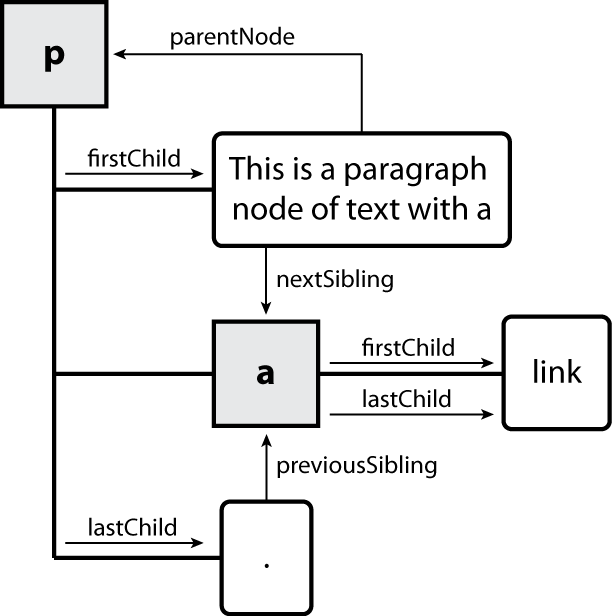
Element vs. text nodes
<div> <p> This is a paragraph of text with a <a href="page.html">link</a>. </p> </div>
- Q: How many children does the
divabove have? - A: 3
- an element node representing the <p>
- two text nodes representing
"\n\t"(before/after the paragraph)
-
Q: How many children does the paragraph have? The
atag? - The paragraph has 3. The anchor has 1.
jQuery traversal methods
Exercise: #box children
- Use the DOM API to target the children of the
boxelement and change their position. - Use the jQuery library to do the same.
Looping over the DOM
- Using the DOM
var elems = document.querySelectorAll("li");
for (var i = 0; i < elems.length; i++) {
var e = elems[i];
// do stuff with e
}
$("li").each(function(idx, e) {
// do stuff with e
});
for each loop on either because they are not technically arrays, just array-like objects.Inside the jQuery each loop
$("li").each(function(idx, e) {
// do stuff with e
});
- return
falseto exit the loop early - e is a plain old DOM object
- We can upgrade it again using
$if we want
- We can upgrade it again using
$("li").each(function(idx, e) {
e = $(e);
// do stuff with e
});
- the
thiskeyword refers to the same selected element as e, so this is better jQuery
$("li").each(function() {
// do stuff with this
});
Modifying DOM nodes
DOM nodes have fields that correspond to the attributes in HTML tags. There are a few exceptions
| HTML attributes | DOM fields |
|---|---|
title |
.title |
id |
.id |
class |
.className |
style="prop: value" |
.style.prop = value |
Getting/setting CSS classes
function highlightField() {
// turn text yellow and make it bigger
var elem = document.getElementById("id");
if (!elem.className) {
elem.className = "highlight";
} else if (elem.className.indexOf("invalid") < 0) {
elem.className += " highlight";
}
}
- JS DOM's
classNameproperty corresponds to HTMLclassattribute - somewhat clunky when dealing with multiple space-separated classes as one big string
classNameis just a string, not an array like we would want
Getting/setting CSS classes in jQuery
function highlightField() {
// turn text yellow and make it bigger
if (!$("#myid").hasClass("invalid")) {
$("#myid").addClass("highlight");
}
}
addClass,removeClass,hasClass,toggleClassmanipulate CSS classes-
similar to existing
classNameDOM property, but don't have to manually split by spaces
Adjusting styles with the DOM
<button id="clickme">Color Me</button>
window.onload = function() {
document.getElementById("clickme").onclick = changeColor;
};
function changeColor() {
var clickMe = document.getElementById("clickme");
clickMe.style.color = "red";
}
| Property | Description |
|---|---|
style
|
lets you set any CSS style property for an element |
- contains same properties as in CSS, but with
camelCasedNames- examples:
backgroundColor,borderLeftWidth,fontFamily
- examples:
Common DOM styling errors
- many students forget to write
.stylewhen setting stylesvar clickMe = document.getElementById("clickme");clickMe.color = "red";clickMe.style.color = "red"; - style properties are capitalized
likeThis, notlike-thisclickMe.style.font-size = "14pt";clickMe.style.fontSize = "14pt"; - style properties must be set as strings, often with units at the end
clickMe.style.width = 200;clickMe.style.width = "200px"; clickMe.style.padding = "0.5em";- write exactly the value you would have written in the CSS, but in quotes
Problems with reading/changing styles
<button id="clickme">Click Me</button>
window.onload = function() {
document.getElementById("#clickme").onclick = biggerFont;
};
function biggerFont() {
var size = parseInt(document.getElementById("#clickme").style.fontSize);
size += 4;
document.getElementById("#clickMe").style.fontSize = size + "pt";
}
styleproperty lets you set any CSS style for an element- problem: you cannot (usually) read existing styles with it
Accessing styles in jQuery
function biggerFont() {
// turn text yellow and make it bigger
var size = parseInt($("#clickme").css("font-size"));
$("#clickme").css("font-size", size + 4 + "pt");
}
cssfunction of the jQuery object allows reading pre-existing styles- gives us the familiar
font-sizesyntax instead offontSize css(property)gets the property value,css(property, value)sets the property value
Common bug: incorrect usage of existing styles
// bad!$("#main").css("top", $("#main").css("top") + 100 + "px");
- the above example computes e.g.
"200px" + 100 + "px",
which would evaluate to"200px100px" -
a corrected version:
// correct $("#main").css("top", parseInt($("#main").css("top")) + 100 + "px");
Exercise: style update, positioning
- Update the bouncing images javascript code to use better jQuery style.
- Use javascript to initially position the element with id
squaredirectly in the center of it's parent. - Add code to make the
#squarechange direction when it reaches the boundary of it's parent.
Unobtrusive styling
function okayClick() {
this.style.color = "red";
this.className = "highlighted";
}
.highlighted { color: red; }
- well-written JavaScript code should contain as little CSS as possible
- use JS to set CSS classes/IDs on elements
- define the styles of those classes/IDs in your CSS file
jQuery method behavior
- Getters typically operate only on the first of the jQuery object's selected elements.
<ul> <li style="font-size: 10px">10px font size</li> <li style="font-size: 20px">20px font size</li> <li style="font-size: 30px">30px font size</li> </ul>
$("li").css("font-size"); // returns '10px' - Setters typically operate on all of the selected DOM elements.
$("li").css("font-size", "15px"); // sets all selected elements to '8px'<ul> <li style="font-size: 15px">10px font size</li> <li style="font-size: 15px">20px font size</li> <li style="font-size: 15px">30px font size</li> </ul>
jQuery method parameters
Many jQuery object methods are overloaded
- getter syntax:
-
$("#myid").css(propertyName); - setter syntax:
-
$("#myid").css(propertyName, value); - multi-setter syntax:
-
$("#myid").css({ 'propertyName1': value1, 'propertyName2': value2, ... }); - modifier syntax:
-
$("#myid").css(propertyName, function(idx, oldValue) { return newValue; });
What do you think the multi-modifier syntax is?
common jQuery mistake
// bad jQuery$("#main").css("top", parseInt($("#main").css("top")) + 100 + "px");
- The above example does not take full advantage of jQuery syntax.
- Does not work if there are multiple selected objects. Why is that?
-
a corrected version:
$("#main").css("top", function(idx, old) { return parseInt(old) + 100 + "px"; }); // good jQuery
jQuery method returns
When there is no other return to make, jQuery methods return the same jQuery object back to you
| method | return type |
|---|---|
$("#myid"); |
jQuery object |
$("#myid").children(); |
jQuery object |
$("#myid").css("margin-left"); |
String |
$("#myid").css("margin-left", "10px"); |
jQuery object |
$("#myid").addClass("special"); |
jQuery object |
jQuery chaining
$("#main").css("color", "red"); $("#main").attr("id", "themainarea"); $("#main").addClass("special");
The implictly returned jQuery object allows for chaining of method calls.
$("img")
.css("color", "red")
.addClass("special")
.src = "foo.png";
Expression return value at each line:
// [<img />, ...] // [<img style="color: red" />, ...] // [<img class="special" style="color: red" />, ...] // cannot chain further because this is an assignment :(
Exercise: another style update
- Add several
divs with a class ofsquareto the html. - Make sure that our code still makes all of them move around the page randomly.
- Clean up the code to take full advantage of jQuery syntax.
- Change the
background-colorof each square when it hits a wall.
jQuery attr() function
- jQuery has a wrapper function for getting/setting various attributes of selected elements.
- Allows us to chain our method calls.
$("img") // poor jQuery style
.css("color", "red")
.addClass("special")
.src = "foo.png";
$("img") // good jQuery style
.css("color", "red")
.addClass("special")
.attr("src", "foo.png");
// we could chain further right here
More node manipulation with jQuery
Suppose you already have a jQuery object, e.g. $("#myid")
| jQuery method | functionality |
|---|---|
.hide() |
toggle CSS display: none on |
.show() |
toggle CSS display: none off |
.empty() |
remove everything inside the element, innerHTML = "" |
.html() |
get/set the innerHTML without escaping html tags |
.text() |
get/set the innerHTML, HTML escapes the text first |
.val() |
get/set the value of a form input, select, textarea, ... |
.height() |
get/set the height in pixels, returns a Number |
.width() |
get/set the width in pixels, return a Number |
DOM innerHTML hacking
Why not just code the previous example this way?
document.getElementById("myid").innerHTML += "<p>A paragraph!</p>";
- Imagine that the new node is more complex:
- ugly: bad style on many levels (e.g. JS code embedded within HTML)
- error-prone: must carefully distinguish
"and' - can only add at beginning or end, not in middle of child list
document.getElementById("myid").innerHTML += "<p style='color: red; " +
"margin-left: 50px;' " +
"onclick='myOnClick();'>" +
"A paragraph!</p>";
Creating new nodes
| name | description |
|---|---|
document.createElement("tag")
|
creates and returns a new empty DOM node representing an element of that type |
document.createTextNode("text")
|
creates and returns a text node containing given text |
// create a new <h2> node
var newHeading = document.createElement("h2");
newHeading.innerHTML = "This is a heading";
newHeading.style.color = "green";
- merely creating a element does not add it to the page
- you must add the new element as a child of an existing element on the page...
Modifying the DOM tree
Every DOM element object has these methods:
| name | description |
|---|---|
appendChild(node)
|
places given node at end of this node's child list |
insertBefore(new, old)
|
places the given new node in this node's child list just before old child
|
removeChild(node)
|
removes given node from this node's child list |
replaceChild(new, old)
|
replaces given child with new node |
var p = document.createElement("p");
p.innerHTML = "A paragraph!";
document.getElementById("myid").appendChild(p);
Removing a node from the page
var bullets = document.getElementsByTagName("li");
for (var i = 0; i < bullets.length; i++) {
if (bullets[i].innerHTML.indexOf("child") >= 0) {
bullets[i].parentNode.removeChild(bullets[i]);
}
}
-
each DOM object has a
removeChildmethod to remove the given child from the page - gross!!!
jQuery manipulation methods
Create nodes in jQuery
The $ function to the rescue again
var newElement = $("<div>");
$("#myid").append(newElement);
jQuery programmers typically 1 line it
$("#myid").append($("<div>"));
The previous example becomes this with jQuery
var bullets = document.getElementsByTagName("li"); for (var i = 0; i < bullets.length; i++) { if (bullets[i].innerHTML.indexOf("children") >= 0) { bullets[i].parentNode.removeChild(bullets[i]); } }
$("li:contains('child')").remove();
Exercise: lots of squares
- Add some number of
.square divs to the page using jQuery. - Change the
divs to beimgtags with asrcof laughing_man.jpg.
Creating complex nodes in jQuery
- The terrible way, this is no better than innerHTML hacking
-
$("<p id='myid' class='special'>My paragraph is awesome!</p>") - The bad way, decent jQuery, but we can do better
-
$("<p>") .attr("id", "myid") .addClass("special") .text("My paragraph is awesome!"); - The good way
-
$("<p>", { "id": "myid", "class": "special", "text": "My paragraph is awesome!" });
jQuery $ function signatures
- Responding to the page ready event
-
$(function);
- Identifying elements
-
$("selector", [context]); - Upgrading DOM elements
-
$(elements);
- Creating new elements
-
$("<html>", [properties]);
DOM example
Here is what it might look like if you tried to insert an image before each special
span tag in a div using the DOM's API.
var spans = document.querySelectorAll("#ex1 span.special");
for (var i = 0; i < spans.length; i++) {
var img = document.createElement("img");
img.src = "images/laughing_man.jpg";
img.alt = "laughing man";
img.style.verticalAlign = "middle";
img.style.border = "2px solid black";
img.onclick = function() {
alert("clicked");
}
spans[i].insertBefore(img, spans[i].firstChild);
}
Poor jQuery example
$("#ex2 span.special").each(function(i, elem) {
var img = $("<img>")
.attr("src", "images/laughing_man.jpg")
.attr("alt", "laughing man")
.css("vertical-align", "middle")
.css("border", "2px solid black")
.click(function() {
alert("clicked");
});
$(elem).prepend(img);
});
Good jQuery example
$("#ex3 span.special").prepend($("<img>", {
"src": "images/laughing_man.jpg",
"alt": "laughing man",
"css": {
"vertical-align": "middle",
"border": "2px solid black"
},
"click": function() {
alert("clicked");
}
}));

